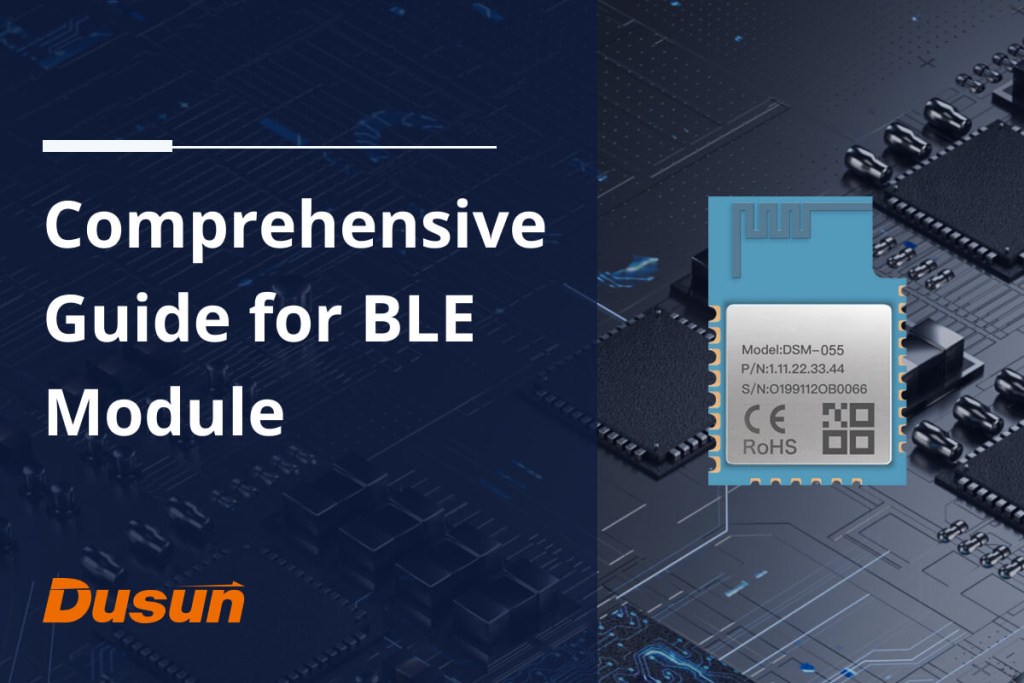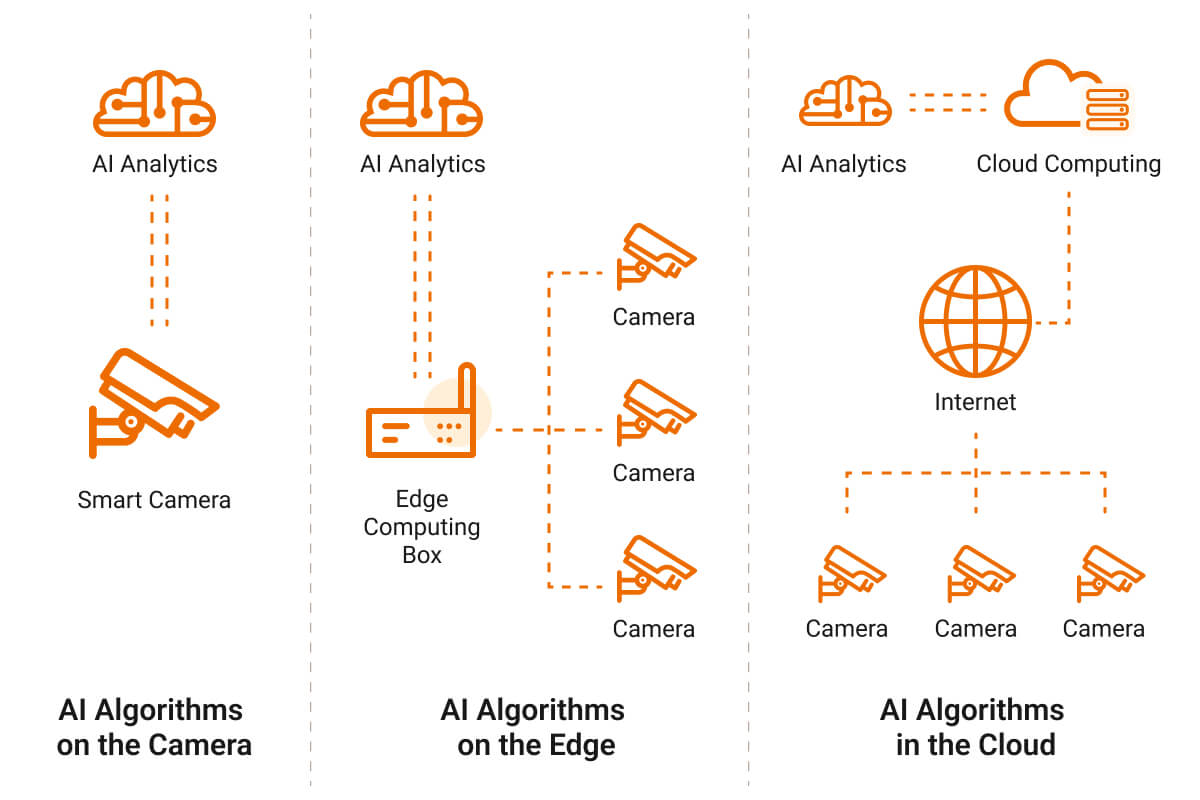Bluetooth low energy module acts as a bridge to let Bluetooth gateways collect various valuable data, including environmental sensor readings (e.g., temperature, humidity), location information, and status updates, etc., from nearby BLE end devices and prepares it for further processing. Once the data is processed or prepared, the BLE module can forward it to other components within the gateway. In addition, the BLE module within the gateway ensures that it can efficiently communicate with various BLE end devices while conserving power.
In order to provide readers with a comprehensive and in-depth understanding of BLE modules and to offer references and convenience in selecting relevant products, this article will cover several aspects of BLE modules, including their definition and applications, functions and roles in IoT, and how to choose BLE modules for IoT applications.
What is BLE Module?
BLE modules are compact and semi-finished products that incorporate BLE capabilities, used by product developers to enable seamless and efficient data exchange between devices, after they finished the functional redevelopment and and packaging of the shell.

A BLE module usually has a basic circuit set of the chip with integrated Bluetooth Low Energy function, enabling wireless communication between devices with minimal energy consumption. BLE modules typically include integrated microcontrollers, RF transceivers, antennas, and other necessary wireless communication components. Compared to traditional Bluetooth modules, BLE modules have lower costs and power consumption, making them more suitable for resource-constrained IoT applications with higher real-time requirements.
In the realm of wireless communication, BLE modules have already emerged as indispensable components that power the Internet of Things (IoT) solutions and various other applications.
Features of BLE Modules
A BLE module is a compact electronic device equipped with Bluetooth Low Energy technology, which is a a wireless communication technology designed for energy efficiency and simplicity. It incorporate multiple features that BLE has:
- Larger Communication Range: BLE modules offer a communication range of approximately 150 meters in open field, providing a reliable wireless communication solution for the majority of IoT applications.
- Small Size: Bluetooth modules can be designed to be smaller than a coin. This small size allows BLE device manufacturers to easily embed the BLE modules into a wide range of electrical devices, including wearables, IoT sensors, smart home appliances, and more, without significantly increasing the size of their products. This enables product designers to optimize internal layouts, create space-efficient products with increase market popularity.
- Convenient Power Supply: BLE modules operate with very low current, ranging from tens of microamps to a few hundred microamps in normal working conditions. As a result, they can be powered by small button batteries, effectively addressing the power supply challenges of low-power Bluetooth devices in IoT.
- Higher Data Transfer Rate: BLE modules support data transfer speeds of up to 2 Mbps, providing reliable support for IoT applications with increasing data volume.
- Security: Ensuring safety and dependability in Bluetooth modules is crucial for a wide range of applications, especially in IoT and wireless communication. The incorporation of advanced encryption technology, such as AES, in Bluetooth modules is crucial in protecting data from unauthorized access and eavesdropping, especially when IoT devices need to exchange data and commands in bidirectional communication.
- Compliance with Standards: Having your Bluetooth modules certified with various industry standards such as CE, FCC, BQB, SRRC, and other relevant certifications is a substantial advantage for your product offerings. These certifications signify that Bluetooth modules comply with the regulatory requirements of different regions and markets, and ensures that your Bluetooth products can be legally sold and used in various countries, facilitating global market access.
Read further: importance of low power consumption in IoT
Dusun IoT’s DSM-055 Bluetooth mesh modules consists of a highly-integrated and high-performance wireless BLE SoC chip EFR32BG21 as well as some peripheral devices (including an on-board PCB antenna with a gain of 2.0dBi). The chip has a variety of built-in firmware used for Bluetooth IoT applications, such as iBeacon/Eddystone, Bluetooth transparent transmission, Bluetooth mesh, Bluetooth scanning, etc., to facilitate rapid redevelopment of BLE products.
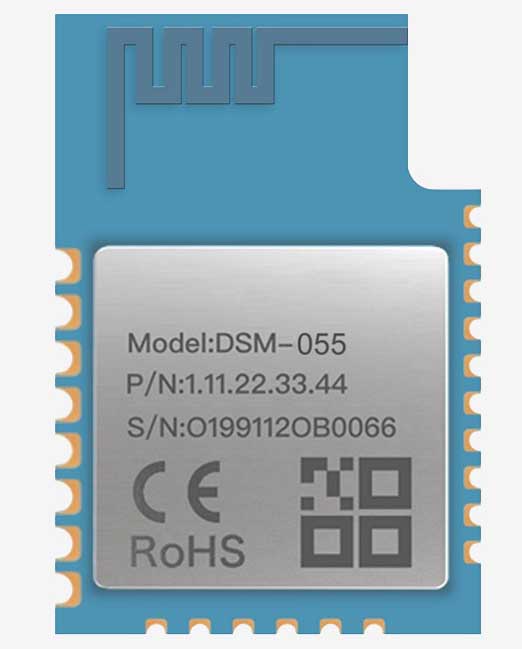
Role of BLE Modules
The primary purpose of BLE modules is to establish efficient and low-power wireless connections between devices. These modules facilitate seamless data exchange over a certain distance, making them ideal for IoT applications that require energy-efficient communication and intermittent data transfer.
BLE modules offers various operating modes, each with distinct characteristics suitable for different IoT applications. Below is a brief introduction to the operating modes of BLE modules to provide developers with a comprehensive understanding of their functionalities.
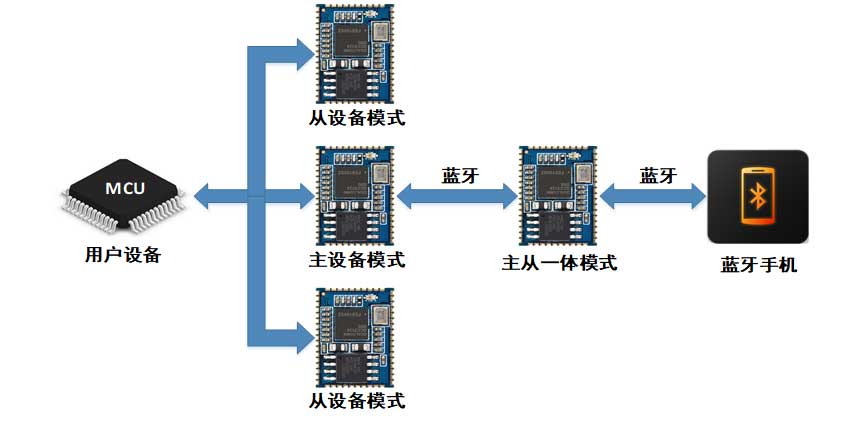
Master Mode
In master mode, a Bluetooth module can search for and connect to desired slave devices within its vicinity. It can send and receive data and can also be configured to automatically connect to a specific slave device using its MAC address, allowing the module to establish a connection as soon as it powers up.
Slave Mode
Bluetooth modules operating in slave mode can only be discovered by master devices and cannot initiate searches themselves. Once connected to a master device, a slave device can exchange data with the master.
Broadcast Mode
In this mode, a Bluetooth module can perform one-to-many broadcasting. Users can use AT commands to configure the data to be broadcasted, and the module can continuously broadcast in a low-power state. This mode is suitable for applications with extremely low power consumption, small data volume, and one-way transmission, such as beacons, billboards, BLE indoor positioning, and Bluetooth beacon asset tracking.
Mesh Networking Mode:
In this mode, multiple modules can be added to a network, utilizing a star network and relay technology. Each network can connect to over 65,000 nodes, and networks can interconnect as well. This allows numerous Bluetooth modules to be interconnected or controlled directly through a smartphone or tablet without an extra gateway. Even if one device fails, data transmission can be routed through the nearest device. The entire networking process only requires devices to power up and set a communication password to achieving simple interconnectivity.
The different operating modes of the BLE module generally support multi-device connection. DSM-055 BLE Module with SiliconLabs EFR32BG21 chipsets supports multiple devices to connect at the same time, and when they are used as BLE masters, 12 BLE slave can be connected at the same time.
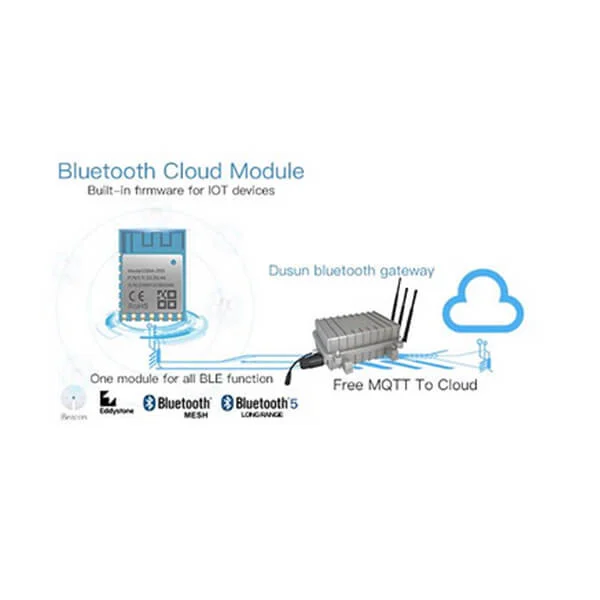
What is the Use of Bluetooth Module?
Understanding the Bluetooth working mode can help IoT device developers quickly determine the Bluetooth working mode according to the application scenario for development. After all, in the field of wireless communication, BLE modules have become indispensable components, powering Internet of Things (IoT) and various other applications.
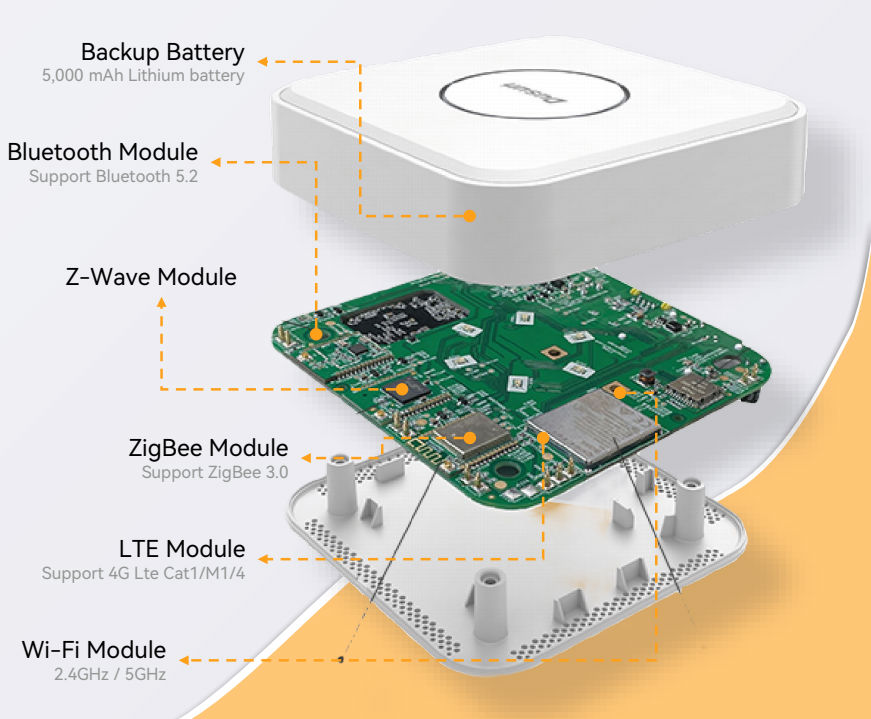
The following is a brief introduction to some common IoT applications developed using the BLE modules:
Smart Homes
BLE module in smart home uses includes smart locks, smart lighting control, smart appliances, etc. BLE temperature humidity sensors can provide real-time data about the home environment; BLE-powered smart locks offer convenient and secure access control by using smartphones as digital keys; Wearable health monitors equipped with BLE allow users to track vital health metrics such as heart rate, activity level, sleep quality, and sync data with smartphone apps for continuous health monitoring, providing valuable insights and early warnings; BLE-based smart lighting systems provide customizable lighting control and ensures efficient and responsive communication between lighting fixtures and control devices.
Asset Tracking
BLE modules can be used to create precise indoor positioning systems, enabling businesses to track assets or provide location-based services in enclosed spaces.
Read further: BLE asset tracking
Industrial Sensing
In the context of smart manufacturing, various terminal sensors with environmental sensing capabilities can use BLE modules to communicate collected data, enabling intelligent monitoring and control during the production process.
Wearable Technology
Fitness trackers, smartwatches, and medical devices utilize BLE modules to transmit data to smartphones or other connected devices, while also conserving battery life.
Bluetooth Gateways
Bluetooth gateway is a device that integrates Bluetooth LE with multiple wireless or wired communication methods such as WiFi, 4G/5G, Ethernet, etc. The Bluetooth beacon gateway supports scanning the broadcasts of surrounding BLE beacon devices and defaults to MQTT reporting. BLE module is the core component responsible for data collection in the BLE gateways. The performance of the BLE module directly determines the efficiency of the Bluetooth gateway in collecting IoT device data and uploading data to the server.
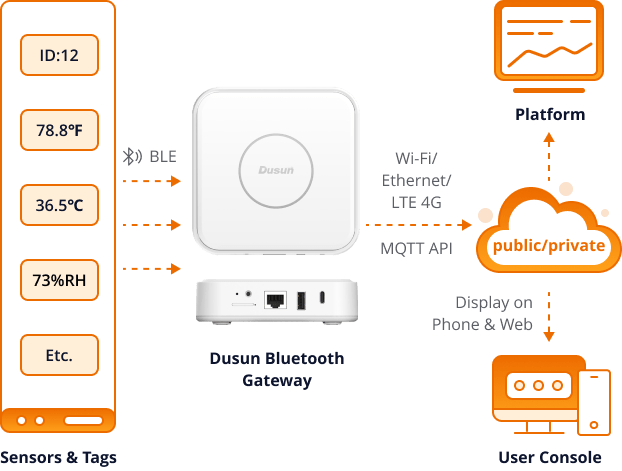
Get to know: What is a Bluetooth gateway? and what is Bluetooth beacon gateway?
What to Consider When Selecting BLE Modules for IoT Applications?
Given the vast array of IoT applications, the emphasis on BLE module functionalities varies across different scenarios. Therefore, selecting BLE module tailored to different IoT applications is very crucial. Below we are going to mentions factors you need to take into account.
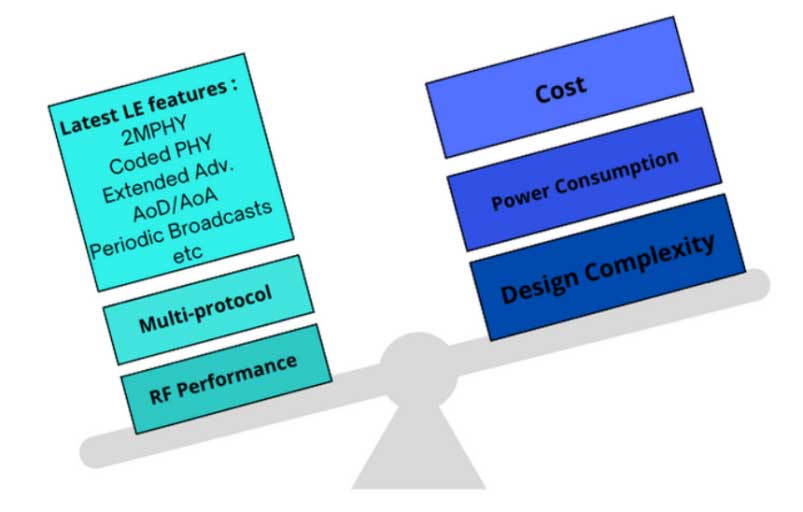
BLE Support
For applications demanding high throughput, modules supporting 2M PHY or extended advertising data packets can be sought-after. If greater communication range is required, Bluetooth long range modules supporting LE Coded PHY should be considered. For BLE positioning and tracking applications, a BLE module with Angle of Arrival (AoA) or Angle of Departure (AoD) capabilities is needed.
Processor Chip
The processor core of a BLE module dictates its processing capability. The quality of the Bluetooth chip directly influences the performance of the BLE module. A chip with excellent processing capabilities and support for rich firmware and software protocol stacks can provide developers with numerous conveniences.
Interfaces
Another crucial factor is the module’s interface types. How the BLE module connects to peripherals other than itself is critical in determining compatibility. You are suggested to choose a BLE module with sufficient processing power and a rich set of interface types.
Integration and Compatibility
Ensure that the chosen BLE module seamlessly integrates with the existing hardware and software components of your application. Good compatibility with popular platforms and development tools can simplify the implementation process and reduce costs.
Signal and RF Performance
BLE modules with high RF sensitivity and output power provide better link budget and extended range without requiring external amplifiers.
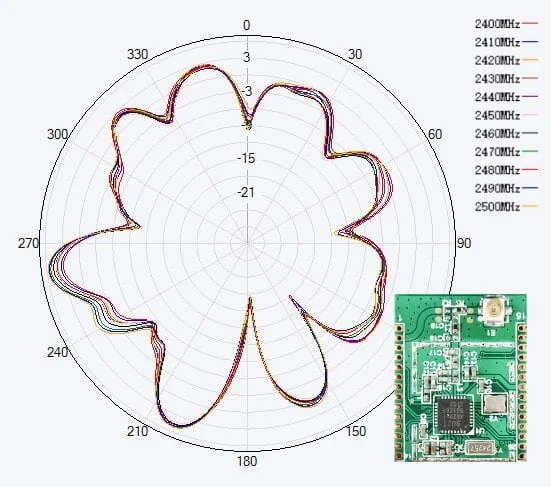
Data Transfer Rate
The data transfer rate of BLE modules can impact the speed of communication between devices. Choosing a module with a data rate that aligns with your application’s requirements is essential.
OTA (Over-The-Air) Updates
OTA updates are crucial for commercial and industrial applications. Select BLE modules that support OTA updates to facilitate timely firmware updates, error fixes, and wireless addition of new features. OTA updates reduce costly downtime and the need for on-site technical access.
Operating Temperature Range
To ensure stable operation of BLE modules over an extended period, the module’s operating temperature range should ideally cover the required environmental temperature of the application. Thus, the ability of a BLE module to operate reliably across a wide temperature range is a key performance indicator.
Operating Current/Voltage and Transmit Power
The operating voltage and current of a Bluetooth module determine its power consumption and stability. Choosing a Bluetooth module with low power consumption and high transmit power means that the Bluetooth RF signal can travel a greater distance, expanding the signal coverage area. High-transmitting-power Bluetooth modules are able to support connections with more remote devices.
Antenna
Different products have varying antenna requirements. Commonly used antennas for Bluetooth modules include PCB antennas, ceramic antennas, and IPEX external antennas. If the module will be placed within a metal enclosure, modules with IPEX external antennas are typically preferred. Antennas with stable gain and wide beamwidth within the operating frequency range enable Bluetooth modules to have more stable connections and broader signal coverage areas.
Advice for Embedding BLE Modules into Your Products
Understanding the foundational principles and applications of BLE modules isn’t the final goal. The ultimate goal is to choose an appropriate BLE module and integrate it into your own IoT hardware development. The following are some detailed steps and recommendations that aim to help you plan and execute this process more effectively:
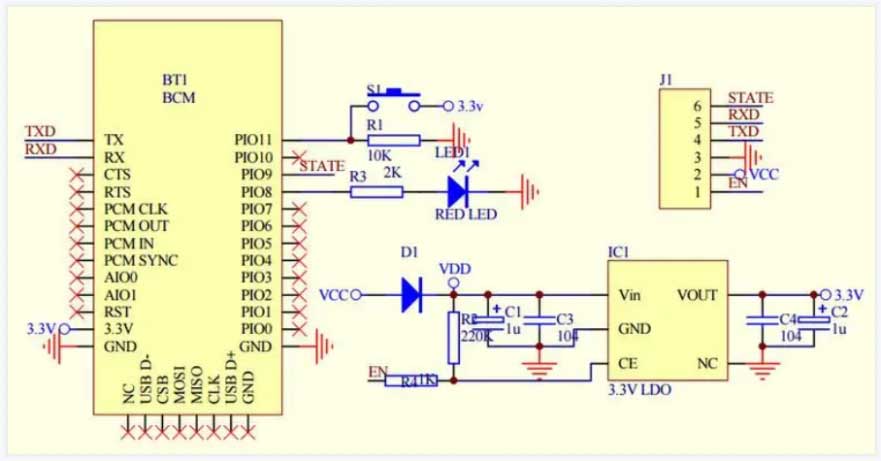
Make Your Goals and Requirements Clear
Clearly define the main functionalities and characteristics of your product and then determine the role and functionalities of Bluetooth in your product. You need to specify performance requirements like connection stability, data transfer rate, power consumption, etc.
Select an Appropriate BLE Module
Based on your product’s requirements, choose a suitable BLE module. What you need to consider involves factors like size, power consumption, performance, etc., like we mentioned before. Decide whether BLE, classic Bluetooth, or both need to be supported.
Hardware Design and Layout
Design the circuit layout for the Bluetooth module, including RF circuitry and antenna placement. Ensure that RF design follows best practices to avoid signal interference and performance issues.
Power Supply and Management
Design an appropriate power circuit to ensure stable power supply. Low-power design strategies can help extend battery life if applicable.
RF Performance Optimization
Conduct RF performance testing, including signal strength and connection range. Optimize antenna and circuit design to enhance connection quality.
Software Development
Learn about Bluetooth protocol stacks and development tools, such as BLE protocol stacks and relevant SDKs, and then develop software code for Bluetooth connection, data transmission, and handling. You need to consider security and data privacy to ensure safe Bluetooth communication.
Testing and Validation
Performing functionality testing on hardware to ensure proper functioning of circuits and Bluetooth modules is of great significance. You can conduct software testing, including Bluetooth connection, data transmission, and handling of exceptional cases.
Product Integration and Debugging
Embed the BLE module into your product and perform overall integration and debugging. You may need to address potential hardware and software interaction issues that may arise.
Remember that this process involves a combination of hardware and software aspects, and it’s important to iterate and test at various stages. Additionally, documentation and version control are essential to keep track of changes and ensure consistency throughout the development process. By following these steps and taking a thorough approach, you can effectively integrate BLE modules into your developer products and create successful IoT applications.
Recommendation for High-Performance BLE Modules
Indeed, selecting a BLE module with balanced performance across all aspects can be very challenging. But Dusun IoT’s DSM-055 Bluetooth low energy module stands out as a all-rounder. Below is an overview of its advantages in IoT applications:

Powerful Processor and Abundant Interface Resources
This module adopts a highly integrated wireless chip EFR32BG21. This chip is a low-power multi-protocol Bluetooth 5.2 SoC launched by Silicon Labs company, supporting BLE, Bluetooth Mesh, Thread, and also supporting the proprietary 2.4GHz protocol. The Cortex-M33 processor is used while it also supports floating-point operations, with a main frequency of 80MHz and Bluetooth Mesh support. It has low-power Bluetooth capability, supports NCP and RCP protocols, and the module also integrates high-quality peripheral hardware, including a receiving and transmitting antenna with 2dBi gain and rich GPIO. These hardware features provide excellent scalability and stable connectivity for this BLE module, ensuring its potential for secondary development.
Complete BLE Support
This module is an all-in-one Bluetooth module, meaning it owns all BLE protocols: Bluetooth 5.2, BLE Long Range, iBeacon/eddy stone, Bluetooth scanning, Bluetooth mesh networking, and more. This allows it to provide broader compatibility and serves a wider range of IoT application scenarios.
High Integration and Compatibility
In terms of hardware, this module supports three types of serial ports: UART, GPIO, and PWM. It can be connected to a variety of peripheral devices and has strong hardware compatibility and functional expansion capabilities. At of the software, Dusun IoT provides free SDK support for users to implement rapid secondary development. The module supports OTA functionality and quickly connects your IoT products to public and private cloud platforms through our Bluetooth gateways.
High Data Transfer Rate
This module supports the Bluetooth 5.2 protocol and has strong data transmission capabilities, which can significantly improve the communication speed between devices and improve the operational efficiency of IoT applications.
Excellent RF Performance
With a transmitting power and receiving sensitivity of 20dBm, the communication distance of the BLE module is longer (up to 150m), the reaction speed is faster, and it is more suitable for long-distance and high-precision IoT applications.
Wide Operating Temperature Range
This BLE module can operate stably within a temperature range of -45°C to 85°C, making it adaptable to certain extreme temperature environments in IoT applications.
Final Word
In conclusion, BLE modules have revolutionized wireless communication by providing efficient and seamless connections for various applications. Compact BLE modules enable IoT devices to communicate, share data, and interact while reducing energy consumption. By carefully evaluating and considering factors like power consumption, communication range, data rate, integration, security, cost, and support, developers can choose the most suitable BLE module.
Dusun IoT’s DSM-055 BLE module excels in many key Bluetooth functionalities and services, making it an ideal choice for IoT developers. This module provides excellent hardware and software support for IoT hardware development, helping realize innovative ideas and create a more connected and efficient world.
FAQs of BLE Modules
What is the difference between Bluetooth and BLE modules?
Bluetooth module is categorized into Classic Bluetooth module and low-powered Bluetooth module based on different application and supported protocols. BLE is often referred to as Bluetooth Smart and is an extension of classic Bluetooth technology, primarily targeting low-power applications such as wearable devices, health monitors, and IoT devices. BLE module has strong adaptability in IoT applications, and does not take up too much bandwidth. Classic Bluetooth supports Bluetooth versions lower than 4.0 and is typically used for relatively big data transmissions like speech and music.
How does Bluetooth module work?
Each Bluetooth device includes a small BLE module and application software that enables wireless electromagnetic wave connections and data transmission with other BLE devices. Due to the constrained communication range, numerous Bluetooth-enabled devices are connected to create a Piconet network, which allows them all to effortlessly communicate as long as they are all within range. One device controls all other devices, which are referred to as slaves, in such a link as the master. Usually, two to twelve devices can often connect to this form of network.
What is BLE mesh gateway, and is it necessary to use BLE mesh gateway?
The Bluetooth mesh gateway is used to forward the data in the Bluetooth mesh network to other networks, such as WiFi network or wired Ethernet network, so that the Bluetooth mesh network can transmit information to the cloud, or other applications. At the same time, the Bluetooth mesh gateway can also forward data from other networks to the Bluetooth mesh network, in order to facilitate data transmission across networks.
Whether you need a BLE mesh gateway depends on your specific IoT application: if your BLE mesh network is self-contained and operate in local control, and it doesn’t need remote access, you might not require a gateway. However, the Bluetooth mesh gateway can further expand the coverage of the Bluetooth mesh network. Therefore, if you want to monitor or control your BLE mesh network remotely, a gateway is essential. BLE mesh gateway enables your BLE mesh network to communicate with other IoT cloud services, and is vital for protocol translation and data forwarding. It is a crucial component of your IoT solution.









